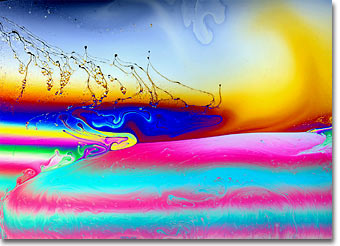Karl E. Deckart
Soap Bubble Gallery: Image Seventeen
German photographer and artist Karl E. Deckart is known for his thorough, precise, and beautiful work both in photography through the microscope and with macro camera systems. This gallery of interference photographs made with soap films is a testament to both Deckart's skill as a photographer and his understanding of the physical phenomena that surround our everyday lives. Presented below is soap bubble image number seventeen in small format. Click on the image to download a larger version.

|
Macrophotography of thin soap films freely suspended on a 4 x 4-inch wire frame was conducted with a Linhof large-format bellows camera system utilizing 4 x 5-inch sheet film and imaged using an apo-macro Nikon large format Nikkor-AM ED 210 mm f-5.6 lens. To prepare the soap film, equal parts of water, glycerin, and dishwasher detergent are thoroughly mixed in a container until a solution containing evenly sized micelles is achieved. A freestanding film is formed by dipping the wire frame into the solution and withdrawing carefully to maintain an even film thickness and avoid disruption of material flow across the frame rails. After suspension, the film was illuminated by a reflected light source positioned a few degrees from the camera system. The light was passed through a diffusion screen to avoid bright spots and provide an even illumination across the field. No polarizers were employed in photomacrography of soap thin films. Image ©1999 by Karl E. Deckart. All rights reserved. |
Levitated on air currents and carried whimsically aloft on a breeze, bubbles surround volumes of air with a shimmering liquid skin. Although wind conditions and vibrations can vary its shape, a solitary floating bubble naturally forms a sphere. This tendency to encase its cargo by seeking the least possible surface area derives from surface tension in the thin vein of water the lies between the microscopically thin soapy films of the bubble membrane. Slightest contact with a surface other than the skin of another bubble and the fragile soapy membrane usually bursts. However, the membrane-like character of the film provides parallel surfaces upon which the interplay of light beautifully produces iridescent colors. Light reflecting from both the inside and outside surfaces interferes constructively to produce multiple colors on the soapy film. Subtle variations in thickness generate swirling patterns of concentrated color.
BACK TO THE SOAP BUBBLE GALLERY
